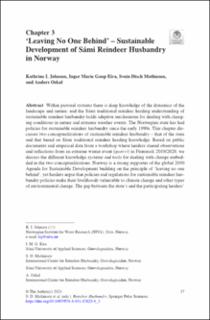| dc.contributor.author | Johnsen, Kathrine Ivsett | |
| dc.contributor.author | Eira, Inger Marie Gaup | |
| dc.contributor.author | Mathiesen, Svein Disch | |
| dc.contributor.author | Oskal, Anders | |
| dc.date.accessioned | 2023-03-23T11:09:33Z | |
| dc.date.available | 2023-03-23T11:09:33Z | |
| dc.date.created | 2023-01-23T18:56:07Z | |
| dc.date.issued | 2022 | |
| dc.identifier.citation | Johnsen, K.I., Eira, I.M.G., Mathiesen, S.D., Oskal, A. (2023). ‘Leaving No One Behind’ – Sustainable Development of Sámi Reindeer Husbandry in Norway. In: Mathiesen, S.D., Eira, I.M.G., Turi, E.I., Oskal, A., Pogodaev, M., Tonkopeeva, M. (eds) Reindeer Husbandry. Springer Polar Sciences. Springer, Cham. | en_US |
| dc.identifier.isbn | 978-3-031-17625-8 | |
| dc.identifier.uri | https://hdl.handle.net/11250/3060090 | |
| dc.description.abstract | Within pastoral systems there is deep knowledge of the dynamics of the landscape and nature; and the Sámi traditional reindeer herding understanding of sustainable reindeer husbandry holds adaptive mechanisms for dealing with changing conditions in nature and extreme weather events. The Norwegian state has had policies for sustainable reindeer husbandry since the early 1990s. This chapter discusses two conceptualizations of sustainable reindeer husbandry – that of the state and that based on Sámi traditional reindeer herding knowledge. Based on public documents and empirical data from a workshop where herders shared observations and reflections from an extreme winter event (goavvi) in Finnmark 2019/2020, we discuss the different knowledge systems and tools for dealing with change embedded in the two conceptualizations. Norway is a strong supporter of the global 2030 Agenda for Sustainable Development building on the principle of ‘leaving no one behind’, yet herders argue that policies and regulations for sustainable reindeer husbandry policies make their livelihoods vulnerable to climate change and other types of environmental change. The gap between the state’s and the participating herders’ understanding of ‘sustainability’ and tools for maintaining the wellbeing of the herd create misunderstandings and mistrust between the actors. Moreover, state decisions undermine the traditional knowledge and practices and push herders to practice a ‘Norwegianized’ type of pastoralism. In the current public management of reindeer husbandry, Sámi traditional reindeer herding knowledge and practices have been left behind. | en_US |
| dc.language.iso | eng | en_US |
| dc.publisher | Springer | en_US |
| dc.relation.ispartof | Reindeer Husbandry. Adaptation to the Changing Arctic, Volume1 | |
| dc.rights | Navngivelse 4.0 Internasjonal | * |
| dc.rights.uri | http://creativecommons.org/licenses/by/4.0/deed.no | * |
| dc.title | ‘Leaving No One Behind’–Sustainable Development of Sámi Reindeer Husbandry in Norway | en_US |
| dc.type | Chapter | en_US |
| dc.description.version | publishedVersion | en_US |
| dc.rights.holder | © 2023 The Author(s) | en_US |
| dc.source.pagenumber | 37-66 | en_US |
| dc.identifier.cristin | 2113570 | |
| dc.relation.project | Norges forskningsråd: 238326 | en_US |
| cristin.ispublished | true | |
| cristin.fulltext | original | |
| cristin.qualitycode | 1 | |

